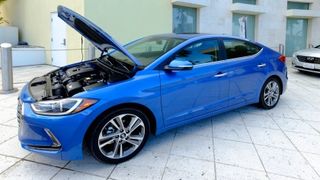Why you can trust TechRadar
Powering the 2017 Elantra is a new version of Hyundai's Nu-family, 2.0-liter four cylinder engine that puts out 147 horsepower (hp) and 132 pound-feet (lb.-ft.) of torque, which is a slight improvement over the previous generation's base 1.8-liter with 145 hp and 130 lb.-ft. The mild improvements are because the new 2.0-liter uses an Atkinson cycle instead of Otto cycle, which trades power density for fuel efficiency and yields a 1 mile per gallon (mpg) gain in the city over the last generation for 28 in the city, 37 on the highway and 32 combined.
The motor is mated to a six-speed automatic transmission, though the base SE can be had with a three-pedal, six-speed manual. Despite the minor improvements to fuel economy and power, the big improvements are in refinement. The new Elantra smoothly sends power to the front wheels.

It's no performance car, but I was able to merge at highway speeds and pass others without the car feeling uncomfortably slow. The motor is also eerily silent at idle and comes to life with the ferocity of four over-caffeinated hamsters at full-throttle, which is typical for economical compact cars.
The Elantra won't win any performance awards but the car drives competently with responsive steering and a comfortable suspension. Hyundai's drive mode selection lets you choose between Normal, Eco and Sport driving modes that alter the response of the electronic power steering.
I briefly drove in normal mode and found the steering too laid back and light, so I spent most of my drive in sport mode. Sport mode had the right amount of weight and steering response for my driving preference, but I prefer to feel road imperfections through the steering wheel.
The suspension absorbs bumps with comfort, and I have no complaints about ride quality. As a commuter car, it does the job well.
Elantra Eco
Coming later this year is an Eco model that trades the 2.0-liter engine for a smaller 1.4-liter turbocharged motor paired with Hyundai's seven-speed dual-clutch (DCT) transmission. Hyundai had a prototype on hand for a quick drive around Imperial Beach.
I took the Elantra Eco out and found it better around town. The 1.4-liter turbo only produces 128 hp, but makes up for it with 156 lb.-ft of torque at a low 1,400 revolutions per minute. It was easy to spin the tires from a stop and the car felt zippy, but at highway speeds, it lost steam past 60 mph.
Hyundai expects the Elantra Eco to return 35 mpg combined, so city fuel economy should be in the low 30 range. The trade off is the Eco doesn't have some some of the nicer features of the Limited, such as, leather seats, HID headlights and driver assist technologies.
Elantra Sport
The trim I'm most excited about is the Elantra Sport, which also comes later this year. Hyundai remained tight-lipped about the Elantra Sport, but did let some details slip. The previous generation Elantra Sport had a Nu 2.0-liter putting out 173 hp, 154 lb.-ft and a standard six-speed manual.
Hyundai claims the new Elantra Sport will come with a 1.6-liter turbocharged four cylinder motor, like the sportier Veloster Turbo. The motor produces 201 hp and 195 lb.-ft. in the Veloster Turbo, which should make the Elantra more entertaining to drive.
But, we will have to patiently wait for it.
Current page: Performance, Eco and Sport trims
Prev Page Infinity sound, Blue Link and driver assists Next Page Verdict
Meta’s massive OS announcement is more exciting than a Meta Quest 4 reveal, and VR will never be the same again

World's fastest broadband connection went live down under — Nokia demos 100 gigabit internet line in Australia in record-breaking attempt but doesn't say when it will go on sale

Don't miss the Samsung Galaxy S23 Ultra for just $849 at Best Buy right now
